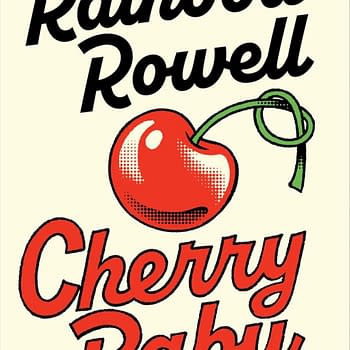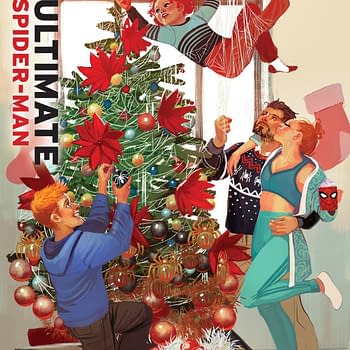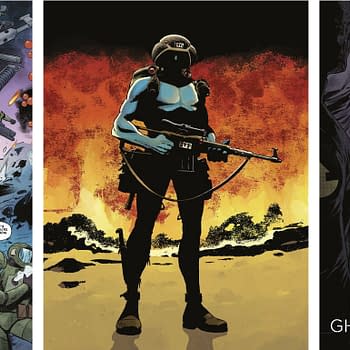Posted in: Comics, Recent Updates | Tagged: Bill Sienkiewicz, Comic strips, Comics, Dave Proch, David Mack, dean haspiel, entertainment, Farel Dalrymple, J.G. Jones, Jim Rugg, kickstarter, Little Nemo: Dream Another Dream, Locust Moon Comics, michael allred, Mike Sgier, Raul Gonzales, Ronald Wimberly, winsor mccay
'A Worthy Ballad To Sing A Graphic Love Song' – Mack, Sienkiewicz, Allred And Many More On Little Nemo: Dream Another Dream
By Nikolai Fomich
Locust Moon Press' Little Nemo: Dream Another Dream Kickstarter has been a resounding success, having raised over $100,000 in less than four weeks. This all new anthology features strips inspired by Winsor McCay's Little Nemo in Slumberland and boasts some of the greatest cartoonists working in comics today. As this Kickstarter campaign nears its end, eight contributors to Dream Another Dream gave their thoughts on what makes this book extraordinary.
David Mack:
"Winsor McCay created an incredible world and body of work over a hundred years ago, and a lot of it includes the basis of visual storytelling vocabulary that we still use and build on in our own comic book storytelling today. This project is an interaction with that creator, his world and grammar from over a decade ago, with some of my favorite creators working today. For me, it is a very personal endeavor, as I discovered Winsor McCay's Lil Nemo in my young formative years when I was just on my way to creating comics. The delight of this project is that we get to play in this world, this laboratory of McCay's Nemo, its language, but I'm very much enjoying creating a personal story inside that context.
In my case, I did a Kabuki story that deals with some of the main themes of my signature character Kabuki, but told in the playful context of the Nemo language with its whimsical and inventive storytelling. The series of pages that I did became a dimension where the themes from Nemo and Kabuki intersect. Each of the pages can be its own one page story, ending with a nod to the character waking, or attempting to wake from the dream land, but each page can also be read in continuous story that builds as it goes, and becomes increasingly personal.
It was a joy to also return to Kabuki in these pages. This year is the 20th anniversary of the publication of Kabuki as a comic book. For each Kabuki volume I've tried to invent a diffusely look and feel and visual approach for each theme of each volume, and much of that attempt at inventiveness and nurturing of a new visual language as the story goes, is in itself an homage and influence of the playful inventiveness in the storytelling McCay builds in every page of Little Nemo. To see the wonderful variety of comic creators in one volume all doing their unique take on this character and these themes is incredible and I am grateful to be a part of it."
Mike Sgier:
From Mike Sgier's Strip
"What really attracted me to this project was the opportunity to contribute to this world that Winsor McCay created so long ago. From a certain point of view, every page, every artist's vision, is a legitimate version of Nemo, and adds to the canon that is Slumberland. McCay created this amazing world, set up the mechanics for it, and showed us all what could be done with it. But it's up to us as artists to continue the story of Slumberland, and to ensure that there will always be visitors to that mythic dream realm.
For my own Little Nemo comic, it started with this image of a giant robot dancing with a giant monster, two figures that were traditionally seen as opponents, but were now recast as lovers. It then grew from there, with Nemo, Princess Camille, Flip and the rest of Slumberland being pulled together around this strange couple. I also wanted to capture this feeling from a very specific dream I experienced, where a wonderful celebration is happening and then something scary occurs for no reason, prompting me to flee. So, Slumberland and its inhabitants gave me a chance to process this experience, and to maybe even make some sense of it in my waking life."
Dave Proch:
"This anthology is going to go down in the history books and to be a part of it is a high honor. The work that I've seen some of the other cartoonists create for this project is beautiful and inspired and I can't wait for the fans to see the finished project…So many artists brought their "A-game," using the scale of the book and the universe of Little Nemo to create some of the best ideas I've seen in comics in years – artists like Jim Rugg, Farel Dalrymple, and J. G. Jones, just to name a few…Winsor McCay was a trailblazing legend, and if we can help get a new generation of readers into his work through this book, then that's a wonderful thing.
Because this might be the only chance in my career as a cartoonist to do something on this scale, I wanted to put as much detail and as many different scenes in my strip as possible, to make my double-page spread something that you can keep coming back to look at. It takes place in a giant's body – his stomach looks different from his heart, which looks different from his brain. There's even a waterfall coming out of his mouth! I wanted every single panel to look like a completely different room, and I wanted it to feel like Nemo went on this incredible adventure, where he saw all these crazy things. I imagined a little kid leaning into this book – it's huge, like a window, so a little kid can lean in and discover something new all along the way. I hope people enjoy it and I especially hope kids enjoy it!"
Raul Gonzalez:
From Raul Gonzalez's Strip
"I have always been fascinated by Little Nemo in Slumberland. Upon discovering the strip decades ago, I immediately wanted to know more about Flip, the Imp and of course Nemo himself. In an attempt to better my drawing skills and to heighten my perception of all things hallucinatory, I indulged in many a Welsh rarebit before sleep. Upon reading about Dream Another Dream and perusing its list of legendary creators, I contacted the fellows at Locust Moon and asked them if I could submit a proposal. The border into Slumberland is an easy one to cross, one needs only to close his eyes, but in reality crossing borders to realize dreams is much more difficult and often times deadly. This was the premise of my strip and I felt like the luckiest guy in the world when I was included. Little Nemo continues to inspire today's cartoonist because of its ethereal nature and Winsor McCay's spirit lives on in each and every page submitted to the anthology."
Bill Sienkiewicz:
"One is left to wonder whether McCay's own sleep was restful or whether he merely transcribed his dreams directly and fully onto the page, like a pen and ink equivalent of that other genius, Nikola Tesla. McCay had the brilliance to provide an underlying structure and rules – endlessly pliable ones, but still – to his dreamscapes. He presaged and evoked Dadaism, Surrealism, Expressionism, but somehow never let any of it feel arbitrary or turn into a navel-gazing masturbatory in-joke for an audience of one. He made something no one had ever seen before seem not only surprising, but also like an inevitability. He made the new familiar, and the familiar strange. As if all the explorations in Little Nemo were simply in our DNA – or in the very air itself – already there, just waiting to be released.
Little Nemo: Dream Another Dream is a book I've wanted to be in for 30 years. To be included among so many artists whose work I admire, and to have discovered so many artists that are new to be but equally inspiring, made this a fantastic venue to pay tribute to the master. In my strip, I wanted to approach the grand ornamentation of Slumberland through the eyes of decay – Slumberland by way of Detroit. And for all the horror of that, most importantly I think, I wanted to leave with the feeling that the dream still goes on."
Dean Haspiel:
"After I decided to dedicate a large chunk of my life to making comix, I discovered Winsor McCay's Little Nemo the same time I learned about George Herriman's Krazy Kat and Cliff Sterrett's Polly and Her Pals. I couldn't believe how artistically sophisticated yet psychedelic those early 20th century comic strips were. I hardly read them because, like the pyramids and Stonehenge, they appeared other-worldly. Dick Tracy and Calvin & Hobbes made much more sense to me.
When I was given the opportunity to contribute to Locust Moon Comics' ambitious Dream Another Dream project, I balked. I didn't think I was worthy in what could arguably be considered this decade's best anthology. In fact, my first attempt, a Billy Dogma ditty, didn't make muster. I walked the walk of shame and figured that was that, but Chris Stevens insisted I had something more to say and challenged me to dig deeper. I thought about Little Nemo and what would happen if he never got out of bed and grew old. Never having taken a chance outside of Slumberland. What would happen if Nemo were to dream another dream and wake up after all these years and…do something. I drew upon Will Eisner's streets, George Herriman's romance, and Jack Kirby's cosmos while, hopefully, evoking the spirit of Winsor McCay."
Ronald Wimberly:
"Nemo… the first time I saw Nemo it gave me the impression of stained glass windows. It's the church of comics, the obscure ancient knowledge of our medium. Each page was a new radical take on the form. I was taken. No one was doing that now.
This book is special because it acknowledges that history and passes the baton to a lot of great contemporary artists in the medium. I know for me it ignited a lot of thought about what I did with comics. My strip uses some ideas of détournement and cut up method to critique some of the themes in Nemo. I took a short story from Edgar Allan Poe and cut it up to suggest some things. Just as McCay is as much the father of what I do as Thelonious Monk or Prince Paul, so I wanted to keep with that spirit in this work. You know, take a standard, smash it against the floor and then put it back together. Hopefully the results are more kintsugi than Frankenstein (although Frankenstein would be great too)."
Michael Allred:

"For most of my life I've been aware of and inspired by the classic strip artists. The greats who really knew how to fill a gigantically innovative newspaper page like Roy Crane, Hal Foster, Frank King, and George Herriman, and of course, the most psychedelic artist before there was psychedelia, Winsor McCay. He was the artist that made up the rules with Little Nemo while simultaneously breaking them. And so, there's no holding me back when given the opportunity to work in that classic massive large scale format. I was so excited to be asked to enter "Slumberland" that I think my idea for my strip was almost immediately fully formed. It was thrilling to be a part of this from the get go, and my enthusiasm has only increased as I've seen each spectacular piece added to the roster, even to the point of obsessive possessiveness! This book is an instant classic and a worthy ballad to sing a graphic love song to Winsor McCay."
Nikolai Fomich is a freelance contributor to Bleeding Cool and college teacher. He is currently researching African history for his comic book series African Odyssey, about a time traveling history professor from Africa's future. Alas, he does not have a Kickstarter…yet.






















